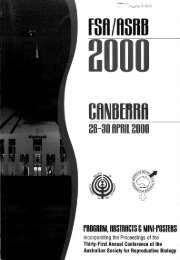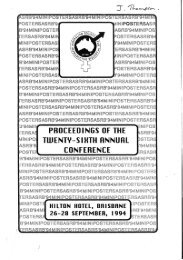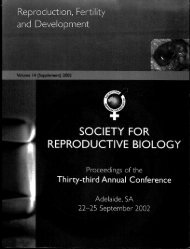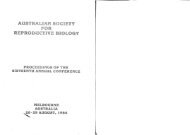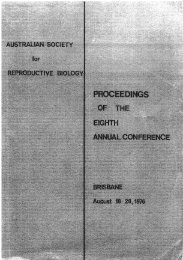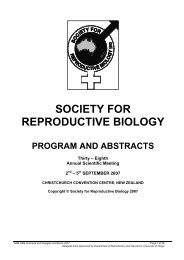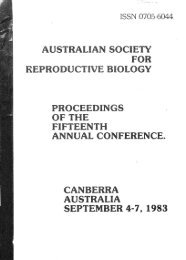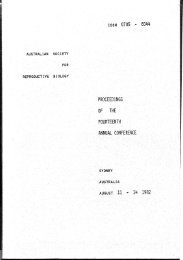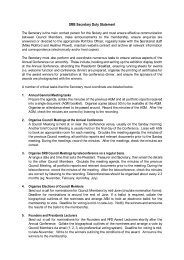N OCIETY' - the Society for Reproductive Biology
N OCIETY' - the Society for Reproductive Biology
N OCIETY' - the Society for Reproductive Biology
Create successful ePaper yourself
Turn your PDF publications into a flip-book with our unique Google optimized e-Paper software.
Monday 27 th September (cont.)SESSION 6:Founders LectureTime: 12.00 - 1.00 pmVenue: Ballroom 2 + 3Chair: Marilyn RenfreeProfessor Ian WilmutRoslin Institute, EdinburghSESSION 7:Monday 27 th September(cont.)Symposium: From Gamete to Embryo - New HorizonsTime: 2.00-4.00 pm Venue: Ballroom 3Chair: Ian Wilmut"Cloning in biology and medicine"Time Format Page Authors Title2.00 0 65 JMCummins Mitochondrial DNA: our alternativegenome2.40 0 66 IPHearn Primate stem cellsProfessor Wilmut obtained a B.Sc. in Agricultural Science at <strong>the</strong> University of Nottingham be<strong>for</strong>e studyingwith Professor "Chris" Polge FRS at <strong>the</strong> University of Cambridge. His Ph.D. degree was awarded in 1971 <strong>for</strong>research on <strong>the</strong> Deep Freeze Preservation of Boar Semen. Subsequent research in Cambridge led to <strong>the</strong> birthof <strong>the</strong> first calf from a frozen embryo - "Frosty" - in 1973.3.20 0 67 B Reubinoff, M Pera, C Human embryonic stem cellsFong, AO TrounsonHe moved to Edinburgh in 1973. Initially, studies at Animal Breeding Research Organisation were focused ondevelopmental and physiological studies of prenatal mortality in sheep and pigs. Subsequent research wasconcerned with developing techniques of multiple ovulation/embryo transfer (MOET) in sheep and cattle.This research established <strong>the</strong> procedures, which are now exploited by PPL Therapeutics at Roslin, <strong>for</strong> <strong>the</strong>production of proteins needed to treat human disease in <strong>the</strong> milk of farm animals.Over <strong>the</strong> past nine years, research has been focused on <strong>the</strong> factors regulating embryo development after nucleartransfer. This work led to <strong>the</strong> first birth of live lambs from embryo-derived cells and <strong>the</strong>n to <strong>the</strong> birth of lambsderived from foetal and adult cells, including Dolly. Recently, genetic changes were introduced into sheep bynuclear transfer from cultured modified cells.As well as being Principal Investigator in Roslin Institute he also serves as Chief Scientific Officer of GeronBio-Med. The objectives of <strong>the</strong> current research are to develop biomedical applications of <strong>the</strong> nuclear transferprocedure. These include <strong>the</strong> provision of organs <strong>for</strong> xenotransplantation, <strong>the</strong> derivation of human cells <strong>for</strong><strong>the</strong>rapy and <strong>the</strong> cloning and modification of animals in agriculture.This symposium is sponsored by:rfdReproduction, Fertility and Development1819



